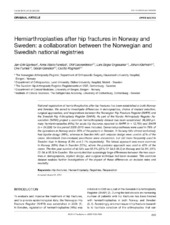| dc.contributor.author | Gjertsen, Jan Erik | en_US |
| dc.contributor.author | Fenstad, Anne Marie | en_US |
| dc.contributor.author | Leonardsson, Olof | en_US |
| dc.contributor.author | Engesæter, Lars B. | en_US |
| dc.contributor.author | Kärrholm, Johan | en_US |
| dc.contributor.author | Furnes, Ove | en_US |
| dc.contributor.author | Garellick, Göran | en_US |
| dc.contributor.author | Rogmark, Cecilia | en_US |
| dc.date.accessioned | 2015-09-23T09:32:14Z | |
| dc.date.available | 2015-09-23T09:32:14Z | |
| dc.date.issued | 2014-05 | |
| dc.identifier.issn | 1724-6067 | |
| dc.identifier.issn | 1120-7000 | |
| dc.identifier.uri | https://hdl.handle.net/1956/10511 | |
| dc.description.abstract | National registration of hemiarthroplasties after hip fractures has been established in both Norway and Sweden. We aimed to investigate differences in demographics, choice of implant selection, surgical approaches, and reoperations between the Norwegian Hip Fracture Register (NHFR) and the Swedish Hip Arthroplasty Register (SHAR). As part of the Nordic Arthroplasty Register Association (NARA) project a common hemiarthroplasty dataset has been established. 36,989 primary hemiarthroplasties (HAs) for acute hip fractures reported to NHFR (n = 12,761) and SHAR (n = 24,228) for the period 2005-2010 were included. Cemented prostheses were used in 78% of the operations in Norway and in 95% of the patients in Sweden. In Norway HAs almost exclusively had bipolar design (98%), whereas in Sweden HAs with unipolar design were used in 42% of the cases. Monoblock (non-modular) prostheses were uncommon, but still more frequently used in Sweden than in Norway (6.9% and 2.1% respectively). The lateral approach was more common in Norway (83%) than in Sweden (52%), where the posterior approach was used in 42% of the cases. The five-year survival of all HAs was 95.5% (95% CI: 94.8-96.2) in Norway and 94.8% (95% CI: 94.4-95.3) in Sweden. We concluded that surprisingly large differences between the two countries in demographics, implant design, and surgical technique had been revealed. This common dataset enables further investigations of the impact of these differences on revision rates and mortality. | en_US |
| dc.language.iso | eng | eng |
| dc.publisher | Wichtig Publishing | eng |
| dc.rights | Attribution CC BY-NC-ND | eng |
| dc.rights.uri | http://creativecommons.org/licenses/by-nc-nd/4.0/ | eng |
| dc.subject | Hip fractures | eng |
| dc.subject | Hemiarthroplasty | eng |
| dc.subject | Registries | eng |
| dc.subject | Reoperation | eng |
| dc.title | Hemiarthroplasties after hip fractures in Norway and Sweden: A collaboration between the Norwegian and Swedish national registries | en_US |
| dc.type | Peer reviewed | |
| dc.type | Journal article | |
| dc.date.updated | 2015-07-30T07:03:46Z | |
| dc.description.version | publishedVersion | en_US |
| dc.rights.holder | Copyright 2014 The Authors | |
| dc.identifier.doi | https://doi.org/10.5301/hipint.5000105 | |
| dc.identifier.cristin | 1160575 | |
| dc.source.journal | HIP International | |
| dc.source.40 | 24 | |
| dc.source.14 | 3 | |
| dc.source.pagenumber | 223-230 | |
| dc.subject.nsi | VDP::Medisinske fag: 700::Klinisk medisinske fag: 750::Ortopedisk kirurgi: 784 | |
| dc.subject.nsi | VDP::Midical sciences: 700::Clinical medical sciences: 750::Orthopaedic surgery: 784 | |

